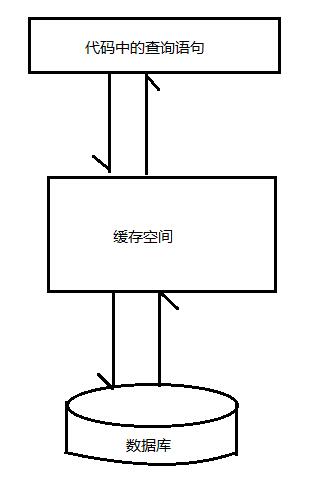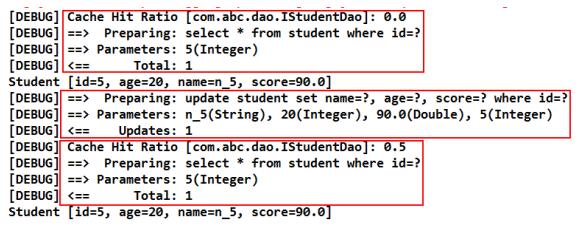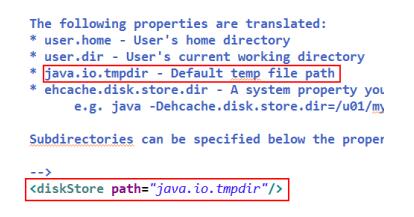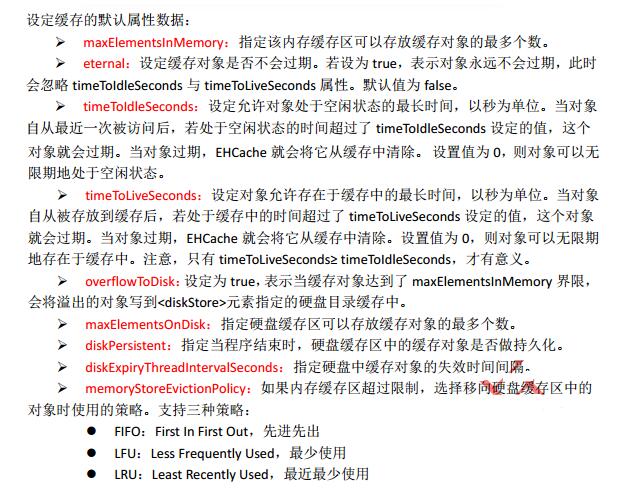查询缓存的使用,主要是为了提高查询访问速度。将用户对同一数据的重复查询过程简化,不再每次均从数据库查询获取结果数据,从而提高访问速度。
mybatis的查询缓存机制,根据缓存区的作用域(生命周期)可划分为两种:一级缓存与二级缓存
一、一级查询缓存
mybatis一级缓存是基于org.apache.ibatis.cache.impl.perpetualcache类的hashmap本地缓存,其作用域是sqlsession。在同一个sqlsession中两次执行相同的sql语句,第一次执行完毕后,会将查询结果写入到缓存中,第二次会从缓存中直接获取数据,而不再到数据库中进行查询,从而提高查询效率。
当一个sqlsession结束后,该sqlsession中的一级缓存也就不存在了。mybatis默认一级缓存是开启状态,且不能关闭。

1.一级缓存的存在性证明
测试类:
|
1
2
3
4
5
6
7
8
9
10
|
//证明一级缓存的存在@testpublic void test01(){ //第一次查询 student student = dao.selectstudentbyid(2); system.out.println(student); //第二次查询 student student2 = dao.selectstudentbyid(2); system.out.println(student2); } |
mapper:
|
1
2
3
4
5
|
<mapper namespace="com.hcx.dao.istudentdao"> <select id=selectstudentbyid resulttype="com.hcx.beans.student"> select * from student where id=#{id} </select></mapper> |
控制台:
执行完后,发现只执行了一次从db中的查询,第二次的结果是直接输出的。说明,第二次是从sqlsession缓存中读取的。

2.从缓存读取数据的依据是sql的id
一级缓存缓存的是相同sql映射id的查询结果,而非相同sql语句的查询结果。因为mybatis内部对于查询缓存,无论是一级查询还是二级查询,其底层均使用一个hashmap实现:key为sql的id相关内容,value为从数据库中查询出的结果。
mapper:
|
1
2
3
4
5
6
7
8
|
<mapper namespace="com.hcx.dao.istudentdao"> <select id=selectstudentbyid resulttype="com.hcx.beans.student"> select * from student where id=#{id} </select> <select id="selectstudnetbyid2" resulttype="com.hcx.beans.student"> select id,name,age,score,birthday from student where id=#{id} </select></mapper> |
dao接口:
|
1
2
3
4
|
public interface istudentdao { student selectstudentbyid(int id); student selectstudentbyid2(int id); } |
测试类:
|
1
2
3
4
5
6
7
8
9
10
11
|
//证明从一级缓存中读取数据的依据://mybatis:sql的id+sql语句//hibernate:查询结果对象的id@testpublic void test02(){ student student = dao.selectstudentbyid(2); system.out.println(student); student student2 = dao.selectstudentbyid2(2); system.out.println(student2); } |
控制台:
查看控制台,发现第二次查询结果与第一次的完全相同,但第二次查询并没有从缓存中读取数据,而是直接从db中进行的查询。这是因为从缓存读取数据的依据是查询sql的映射id,而非查询结果。

3.增删改对一级查询缓存的影响
增删改操作,无论是否进行提交sqlsession.commit(),均会清空一级查询缓存,使查询再次从db中select。
测试类:
|
1
2
3
4
5
6
7
8
9
|
@testpublic void test03(){ student student = dao.selectstudentbyid(2); system.out.println(student); //增删改操作都会清空一级缓存,无论是否提交 dao.insertstudent(new student("赵六",26,96.6)); student student2 = dao.selectstudentbyid(2); system.out.println(student2); } |
控制台:

二、内置二级查询缓存
mybatis查询缓存的作用域是根据映射文件mapper的namespace划分的,相同namespace的mapper查询数据存放在同一个缓存区域。不同namespace下的数据互不干扰。
无论是一级缓存还是二级缓存,都是按照namespace进行分别存放的。但一、二级缓存的不同之处在于,sqlsession一旦关闭,则sqlsession中的数据将不存在,即一级缓存就不复存在。而二级缓存的生命周期会与整个应用同步,与sqlsession是否关闭无关。
使用二级缓存的目的,不是共享数据,因为mybatis从缓存中读取数据的依据是sql的id,而非查询出的对象。所以,二级缓存中的数据不是为了在多个查询之间共享(所有查询中只要查询结果中存在该对象的,就直接从缓存中读取,这是对数据的共享,hibernate中的缓存就是为了共享,但mybatis不是),而是为了延长该查询结果的保存时间,提高系统性能。
1.二级缓存用法
二级缓存的使用只需要完成两步:
序列化实体
在mapper映射文件中添加<cache/>标签
1.实体序列化
要求查询结果所涉及到的实体类要实现java.io.serializable接口。若该实体类存在父类,或其具有域属性,则父类与域属性类也要实现序列化接口。
|
1
2
3
4
5
6
|
public class student implements serializable{ private integer id; private string name; private int age; private double score;} |
2.mapper映射文件中添加<cache/>标签
在mapper映射文件中的<mapper/>标签中添加<cache/>子标签
|
1
2
3
4
5
6
|
<mapper namespace="com.hcx.dao.istudentdao"> <cache/> <select id=selectstudentbyid resulttype="com.hcx.beans.student"> select * from student where id=#{id} </select></mapper> |
3.二级缓存的配置
为<cache/>标签添加一些相关属性设置,可以对二级缓存的运行性能进行控制。若不指定设置,则均保持默认值。
|
1
2
|
<cache eviction="ifio" flushinterval="10800000" readonly="true" size="512"/> |
eviction:逐出策略。当二级缓存中的对象达到最大值时,就需要通过逐出策略将缓存中的对象移出缓存。默认为lru。常用的策略有fifo和lru
flushinterval:刷新缓存的时间间隔,单位毫秒。这里的刷新缓存即清空缓存。一般不指定,即当执行增删改时刷新缓存。
readonly:设置缓存中数据是否只读。只读的缓存会给所有调用者返回缓存对象的相同实例,因此这些对象不能被修改,这提供了很重要的性能优势。但读写的缓存会返回缓存对象的拷贝。这会慢一些,但是安全,因此默认是false。
size:二级缓存中可以存放的最多对象个数。默认为1024个。
2.二级缓存的存在性证明
对于映射文件中的同一个查询,肯定是同一个namespace中的查询。在一次查询后,将sqlsession关闭,再进行一次相同查询,发现并没有到db中进行select查询,说明二级缓存是存在的。
|
1
2
3
4
5
6
7
8
9
10
11
12
13
|
//证明二级缓存的存在@testpublic void test01(){ //第一次查询 student student = dao.selectstudentbyid(2); system.out.println(student); sqlsession.close(); sqlsession = mybatisutils.getsqlsession(); dao = sqlsession.getmapper(istudentdao.class); //第二次查询 student student2 = dao.selectstudentbyid(2); system.out.println(student2); } |
查看控制台:
cache hit ratio表示缓存命中率。开启二级缓存后,每执行一次查询,系统都会计算一次二级缓存的命中率。第一次查询也是先从缓存中查询,只不过缓存中一定是没有的。所以会再从db中查询。由于二级缓存中不存在该数据,所以命中率为0.但第二次查询是从二级缓存中读取的,所以这一次的命中率为1/2=0.5。当然,若有第三次查询,则命中率为1/3=0.66

3.增删改对二级缓存的影响
增删改操作,无论是否进行提交sqlsession.commit(),均会清空一级、二级缓存,使查询再次从db中select。
测试类:
|
1
2
3
4
5
6
7
8
9
10
11
12
13
|
@testpublic void test02(){ //第一次查询 student student = dao.selectstudentbyid(2); system.out.println(student); sqlsession.close(); sqlsession = mybatisutils.getsqlsession(); dao = sqlsession.getmapper(istudentdao.class); //插入 dao.insertstudent(new student("",0,0)); //第二次查询 student student2 = dao.selectstudentbyid(2); system.out.println(student2); } |
控制台:
注意,在第二次查询时的缓存命中率为0.5,但还是从db中查询了。说明在缓存中与该查询相对应的key是存在的,但其value被清空。而value被清空的原因是前面执行了对db的增删改操作,所以不会从缓存中直接将null值返回,而是从db中进行查询。

说明:
二级缓存的清空,实质上是对所查找key对应的value置为null,而非将<key,value>对,即entry对象删除。
从db中进行select查询的条件是:缓存中根本不存在这个key或者缓存中存在该key所对应的entry对象,但value为null。
设置增删改操作不刷新二级缓存:
若要使某个增、删或改操作不清空二级缓存,则需要在其<insert/>或<delete/>或<update/>中添加属性flushcache="false",默认为true。
|
1
2
3
|
<insert id="insertstudent" flushcache="false"> insert into student(name,age,score) values(#{name},#{age},#{score}) </insert> |
4.二级缓存的关闭
二级缓存默认为开启状态。若要将其关闭,则需要进行相关设置。
根据关闭的范围大小,可以分为全局关闭和局部关闭
1.全局关闭(在配置文件中设置)
全局关闭是指整个应用的二级缓存全部关闭,所有查询均不使用二级缓存。全局开关设置在主配置文件的全局设置<settings/>中,该属性为cacheenabled,设置为false,则关闭;设置为true,则开启,默认值为true。即二级缓存默认是开启的。
|
1
2
3
4
|
<!-- 关闭二级缓存 --><settings> <setting name="cacheenabled" value="false"/></settings> |
2.局部关闭(在映射文件的每个select中设置)
局部关闭指整个应用的二级缓存是开启的,但只是针对某个<select/>查询,不使用二级缓存。此时可以单独只关闭该<select/>标签的二级缓存。
在该要关闭二级缓存的<select/>标签中,将其属性usecache设置为false,即可关闭该查询的二级缓存。该属性默认为true,即每个<select/>查询的二级缓存默认是开启的。
|
1
2
3
4
|
<!--usecache="false"对当前sql的二级缓存的局部关闭 --> <select id=selectstudentbyid usecache="false" resulttype="com.hcx.beans.student"> select * from student where id=#{id} </select> |
5.二级缓存的使用原则
1.只能在一个命名空间下使用二级缓存
由于二级缓存中的数据是基于namespace的,即不同namespace中的数据互不干扰。在多个namespace中若均存在对同一个表的操作,那么这多个namespace中的数据可能就会出现不一致现象。
2.在单表上使用二级缓存
如果一个表与其它表有关联关系,那么久非常有可能存在多个namespace对同一数据的操作。而不同namespace中的数据互补干扰,所以就有可能出现多个namespace中的数据不一致现象。
3.查询多于修改时使用二级缓存
在查询操作远远多于增删改操作的情况下可以使用二级缓存。因为任何增删改操作都将刷新二级缓存,对二级缓存的频繁刷新将降低系统性能。
三、ehcache二级查询缓存
mybatis允许使用第三方缓存产品。ehcache就是其中一种。
注意:使用ehcache二级缓存,实体类无需实现序列化接口。
1.导入jar包

2.添加ehcache.xml
解压ehcache的核心jar包ehcache-core-2.6.8.jar,将其中的一个配置文件ehcache-failsafe.xml直接放到项目的src目录下,并更名为ehcache.xml
(1)<diskstore/>标签
指定一个文件目录,当内存空间不够,需要将二级缓存中数据写到硬盘上时,会写到这个指定目录中。其值一般为java.io.tmpdir,表示当前系统的默认文件临时目录。

当前文件系统的默认文件临时目录,可以通过system.property()方法查看:
|
1
2
3
4
5
|
@testpublic void test(){ string path = system.getproperty("java.io.tmpdir"); system.out.println(path);} |
(2)<defaultcache/>标签


3.启用ehcache缓存机制
在映射文件的mapper中的<cache/>中通过type指定缓存机制为ehcache缓存。默认为mybatis内置的二级缓存org.apache.ibatis.cache.impl.perpetualcache。
|
1
2
3
4
5
6
|
<mapper namespace="com.hcx.dao.istudentdao"> <cache type="org.mybatis.caches.ehcache.ehcachecache"/> <select id=selectstudentbyid resulttype="com.hcx.beans.student"> select * from student where id=#{id} </select></mapper> |
4.ehcache在不同mapper中的个性化设置
在ehcache.xml中设置的属性值,会对该项目中所有使用ehcache缓存机制的缓存区域起作用。一个项目中可以有多个mapper,不同的mapper有不同的缓存区域。对于不同缓存区域也可进行专门针对于当前区域的个性设置,可通过指定不同mapper的<cache>属性值来设置。
<cache>属性值的优先级高于ehcache.xml中的属性值。
|
1
2
3
4
5
6
|
<mapper namespace="com.hcx.dao.istudentdao"> <cache type="org.mybatis.caches.ehcache.ehcachecache"/> <property name="maxelementsinmemory" value="5000"/> <property name="timetoidleseconds" value="240"/> </cache></mapper> |
以上所述是小编给大家介绍的mybatis查询缓存实例详解,希望对大家有所帮助,如果大家有任何疑问请给我留言,小编会及时回复大家的。在此也非常感谢大家对服务器之家网站的支持!
原文链接:http://www.jianshu.com/p/90a34862dcdc















